Region: Latin America and the Caribbean
Creative’s Dick McCall: Conflict is Certain for Nation-States without Functioning Institutions
.[vc_row][vc_column width=”1/1″][vc_column_text]
Creative’s Dick McCall: Conflict is Certain for Nation-States without Functioning Institutions
By Alexandra Pratt
[/vc_column_text][/vc_column][/vc_row][vc_row][vc_column width=”2/3″][vc_column_text]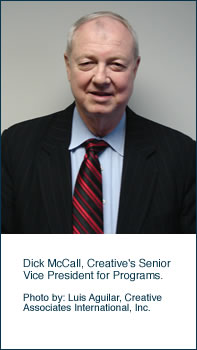 Rebuilding failed states requires a good dose of diplomacy, but without effective institutions to ensure the rule of law and an engaged citizenry, the efforts are doomed to fail, says Dick McCall, Creative’s Senior Vice President for Programs.
Rebuilding failed states requires a good dose of diplomacy, but without effective institutions to ensure the rule of law and an engaged citizenry, the efforts are doomed to fail, says Dick McCall, Creative’s Senior Vice President for Programs.
McCall presented at a “Nation-State Building 101 Workshop” on peacekeeping operations and social reconciliation to personnel from the U.S. Department of Defense and U.S. Army War College Peace Keeping and Stability Operations Institute. The workshop was held this fall at the Center for Naval Analysis in Alexandria, Virginia.
Speaking of post-Cold War challenges, McCall said that ethnic, religious, cultural or nationalistic fault lines have led to the unraveling of “states with very few attributes of nationhood, such as the institutional underpinnings of legitimate governance, the foundation upon which viable nation states are built.”
“What we have failed to understand is that once an authoritarian state collapses or is overthrown, there is no institutional underpinning or coherence in these societies,” McCall said. “In the absence of functioning institutions that reflect a working consensus within these societies, particularly those diverse in their ethnic and sectarian makeup, the potential for re-emergence of violent conflict is a certainty.”
McCall is no stranger to on-the-ground complexities of conflict and reconciliation. He was engaged in the peace process between the warring sides in El Salvador and helped stabilize ethnic differences in the aftermath of genocide in Rwanda.
“In virtually every conflict or post-conflict country in which I have worked, I have found there to be a strong identity at the community level, ethnic or sectarian, but no sense of national identity. The processes of institution building at all levels of society can transcend the divisive nature of localism, or communalism, such as ethnic and sectarian,” McCall said. “Institutions reflect the accepted rules of the game, clearly defining individual rights and responsibilities within the broader community of interests.”[/vc_column_text][/vc_column][vc_column width=”1/12″][/vc_column][vc_column width=”1/4″][vc_widget_sidebar sidebar_id=”sidebar-primary”][/vc_column][/vc_row]
HONDURAS: AJR’s Grand Scheme Culminates in Municipal Crime Prevention Plans
.[vc_row][vc_column width=”1/1″][vc_column_text]
HONDURAS:
AJR’s Grand Scheme Culminates in Municipal Crime Prevention Plans
[/vc_column_text][/vc_column][/vc_row][vc_row][vc_column width=”2/3″][vc_column_text]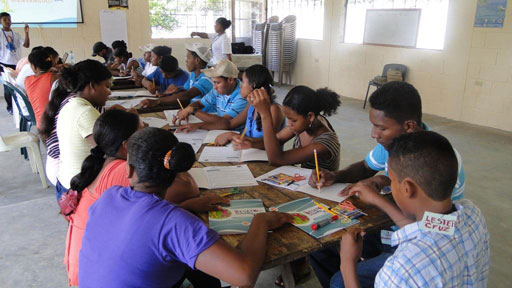
Constructive engagement of youth – promises long-term gains for Honduras.
The totality of the human costs of violence is hard to quantify. But, trauma, loss of social capital and trust and extortion of local businesses have a crippling effect on basic political and economic development in any community. Since 1999, and despite the brokering of peace agreements, homicides have increased in El Salvador, Guatemala and Honduras making some of their cities among the most violent in the world.
In Honduras, about 42 percent of homicides committed are in the northern cities of San Pedro Sula, Choloma and La Ceiba where approximately 1.5 million people, or about 20 percent of the country’s population, reside. Homicides in these cities range from 158 homicides per 100,000 inhabitants in La Ceiba, to 80 in Choloma with sum total of homicides in the three cities accounting for over 25 percent of the national total.
More alarmingly, preliminary data for 2010 indicate that homicides in the three cities grew by 35 percent versus a national increase of about 20 percent. Do these grim statistics indicate that it’s too late to stop the violence? Is the fight lost? Not according to the Regional Youth Alliance USAID-SICA project which is planting seeds of hope for the worst off communities through launching a comprehensive strategy against violence in La Ceiba, Choloma and San Pedro Sula, reaching youth who are the primary perpetrators and victims of crime.
Beginning with the establishment of neighborhood Outreach Centers in 2008 that provide a safe space for youth to mingle, get assistance with homework, and access vocational courses, the AJR USAID-SICA project has structured these Centers to run on a shoe string budget with one staff person coordinating activities conducted by volunteers. Moreover, the Centers are supported by municipal governments, the private sector and religious institutions. Most recently, the Creative-implemented AJR USAID-SICA’s engagement to reduce violence has culminated in Municipal Crime Prevention Plans in Honduras’s three most violent cities.
“This is a collaborative effort on an issue that no single layer of government or sector is capable of solving and in which all, including civil society and the private sector have an important role to play,” said Salvador Stadthagen, Director for Honduras of the AJR USAID-SICA, project which is based in El Salvador where similar interventions are taking place.
At the core of AJR USAID-SICA’s philosophy is that preventive measures provide the greatest promise for curtailing violence and bridging the vast gap in guidance, structure, and goal setting that is so essential to youth. As such, the project’s holistic interventions range from establishing Outreach Centers to employment programs that involve the private sector, to youth movements against violence and to Municipal Prevention Plans that receive the support of municipal authorities.
AJR USAID-SICA activities have caught the imagination and participation not only of thousands of youth, but also the backing of ordinary citizens and of course municipal authorities who are now developing regulations that take account of the special needs of youth and women. Most impressive is that the project has also caught the attention of well known musicians who have given their time and talent to hold concerts and develop theme songs against violence that are now broadcast on the radio and TV.
The city of Choloma, known as Honduras’s industrial hub for its factories, is heavily impacted by the use and sale of drugs in neighborhoods with high unemployment, young people loitering in the streets, and sparse spaces for youth recreation. The conditions in Choloma were highlighted by the Violence Diagnostic conducted by the AJR USAID-SICA, providing a wakeup call that drove the city’s Municipal Crime Prevention Committee to conceptualize a Violence Prevention Plan bearing the slogan Choloma, Ciudad de Oportunidades, or Choloma City of Opportunities, that features vocational training, jobs, and sports for youth most vulnerable to violence.
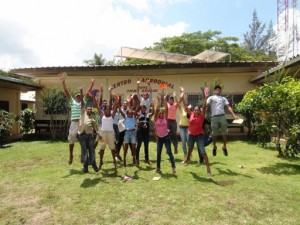 |
| Outreach Center beneficiaries celebrate better times. |
The launch Choloma’s Plan took place on February 9th on a hot afternoon. It was kicked off by the siren of the local fire department drawing 1,000 marchers and many more onlookers on its Caminata por la Vida de los Jóvenes Cholomeños or “Walk for Life with Youth from Choloma.” Making their way to Choloma’s city park down the boulevard on a march that covered ten city blocks, citizens carried banners and sang out slogans and quenched their thirst with drinks provided by a local beverage company. “Today the municipality of Choloma wants to show that you can prevent violence and to invite youth now, that we see Choloma as a City of Opportunities,” said the city’s Mayor, Leopoldo Crivelli, who took part in the events.
Following the march, a video was produced by young people themselves to communicate the essence of the non-violence campaign. A theme song “Choloma, what is happening to us?” was composed by 26-year old Darlan Mendoza head of an educational center who led the celebratory concert. “Thanks to programs like the Regional Youth Alliance USAID-SICA today we have an Outreach Center [here] in López Arellano and I can proudly say that I am from this community,” said Sindy Barahona, volunteer of the López Arellano Outreach Center and collaborator at the prevention plan launch.
While the momentum that AJR USAID-SICA has created in Honduras’s three most violent cities can be likened to an oasis in a desert, it is a beginning. Hope springs eternal, especially when harnessing the spirit and energy of youth and to enable them to develop goals, a sense of the future and most importantly civic duty.[/vc_column_text][/vc_column][vc_column width=”1/12″][/vc_column][vc_column width=”1/4″][vc_widget_sidebar sidebar_id=”sidebar-primary”][/vc_column][/vc_row]
WASHINGTON: CSIS Lauds Creative-implemented USAID/OTI Colombia Rapid Response Project
.[vc_row][vc_column width=”1/1″][vc_column_text]
WASHINGTON:
CSIS Lauds Creative-implemented USAID/OTI Colombia Rapid Response Project
[/vc_column_text][/vc_column][/vc_row][vc_row][vc_column width=”2/3″][vc_column_text]
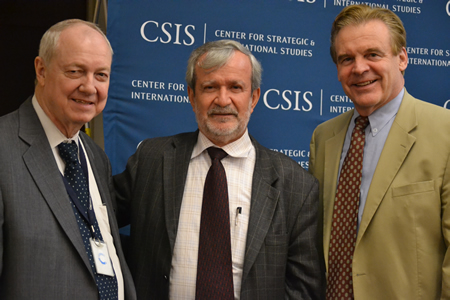
On July 13th, the Center for Strategic and International Studies (CSIS) held the first public discussion on the successes of the USAID-funded and Creative-implemented $50 million Initial Governance Response Program (IGRP), known by the component names—Colombia Responde, PROGRESO, and Planes de Transición. IGRP was designed to strengthen the Government of Colombia’s credibility and legitimacy in areas recently reclaimed from illegal armed groups. From February 2007 to July 2011, Creative worked with Colombian citizens to address community concerns by dispersing over 940 grants’ timeliness and transparency boosted citizens’ confidence in their government’s capacity to respond to their basic needs and enhance community cohesion through activities such as water and sanitation programs, construction of schools and health centers, and small scale economic development, including infrastructure projects to repair and construct bridges, secondary and tertiary roads, box culverts, community centers, and sports courts.

The PROGRESO economic development component, launched in November 2007, linked rural farmers with Government of Colombia programs and market opportunities in order to increase rural production and economic generation. The component aimed to increase the income and improve the standards of living of small and medium producers through the support of short term licit activities; strengthen the credibility and legitimacy of the GOC in post-conflict areas in Meta to increase the willingness and capacity of communities to cooperate and interact with the GOC, and to improve the GOC’s capacity to respond to community-prioritized necessities in a timely and credible manner. As designed, the IGRP provided and tested a rapid response mechanism of alternative development in transition environments in order to identify lessons learned for implementation in conflict zones.
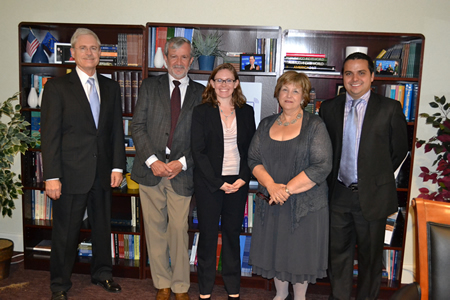
The event titled, “Returning Government to Colombia’s Conflict Zones: A Light Footprint,” provided evaluation results (and lessons learned) conducted about IGRP by CSIS and the United States Institute for Peace (USIP). According to CSIS, the event “set the scene for a discussion of how this approach [IGRP] can address Colombia’s ongoing security and development needs.” To ensure multiple perspectives, CSIS invited Alvaro Balcazar, First Civil Coordinator of the Plan de Consolidación Integral de la Macarena (PCIM), and Diego Meyer Artunduaga, Mayor of San Juan de Arama, Meta to provide a field perspective. Stephen Johnson—Director and Senior Fellow, CSIS Americas Program—gave an introduction and Susan Reichle—former USAID Colombia Mission Director and current USAID Assistant Administrator, Bureau of Policy, Planning, and Learning—gave an overview of IGRP. General commentary and the evaluation process and results were provided by Johanna Mendelson Forman—Senior Associate, CSIS Americas Program and Simon Chair in Political Economy; Robert D. Lamb—Senior Fellow and Director, Program on Crisis, Conflict, and Cooperation (C3); and Phillip McLean—Senior Associate, CSIS Americas Program.
An article on the IGRP program will be forthcoming in the autumn edition of Creative magazine. For additional information on IGRP and the CSIS event, please click here.
Click here for the CSIS Program Evaluation
Click here for Mr. Balcazar’s presentation[/vc_column_text][/vc_column][vc_column width=”1/12″][/vc_column][vc_column width=”1/4″][vc_widget_sidebar sidebar_id=”sidebar-primary”][/vc_column][/vc_row]
HONDURAS: Outreach Centers, Proactive Prevention and Winning Youth
.[vc_row][vc_column width=”1/1″][vc_column_text]
HONDURAS:
Outreach Centers, Proactive Prevention and Winning Youth
[/vc_column_text][/vc_column][/vc_row][vc_row][vc_column width=”2/3″][vc_column_text]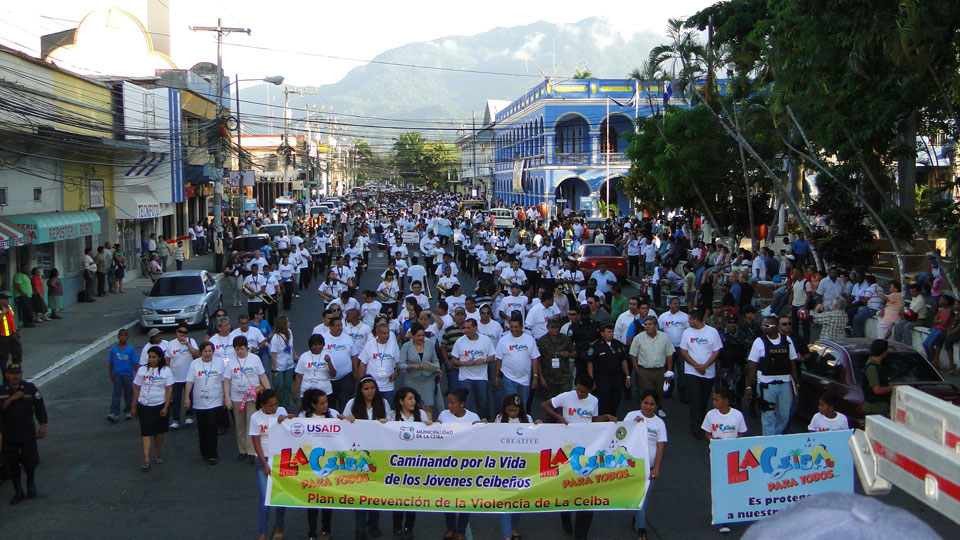
More than 2,000 marchers display citizen pride in La Ceiba para Todos.
Few roads lead to Puerto Lempira located along the Atlantic coastline about 185 miles northeast of Honduras’s capital city, Tegucigalpa, making it one of the most isolated areas of the country. Accessible only by plane or boat, there are few signs here that indicate globalization has had any trickle-down effect. Paved roads are few; livelihoods remain at a subsistence level and increasing narcotics trafficking in the area make life precarious.
Mostly populated by the Miskito whose spoken language is a mixture of Indian, Spanish, African and English, the area is becoming noticed because of the growth in crime that its proximity to the drug trade route has caused. From a sleepy hamlet where a successful day was marked by a solid meal, Puerto Lempira has become, in the last few months alone, a combat theatre between drug lords with heavy weapons. Not even daylight provides protection from this wave of violence given that assassinations occur in broad day light.
“While in general the homicide rate in Puerto Lempira has been low compared to the rest of Honduras, nowadays there are incidents where bales of drugs wash ashore. The town has seen a recent wave of violence, the situation is clearly deteriorating.” said Salvador Stadthagen, who directs the AJR USAID-SICA project for Creative Associates International, a Washington, D.C.-based international development firm. “There are almost no employment opportunities here and fewer opportunities to gain skills.”
Lack of opportunity and lots of free time are like a pressure cooker for the town’s youth who are increasingly finding an escape in drug use. Those with some familiarity to this part of the Atlantic coastline also say that while couriers used to be paid in cash, they are now being paid with drugs which they in turn sell on the streets of Puerto Lempira.
“We conducted a baseline study in five cities around Honduras and it showed that Puerto Lempira provides the least opportunities for youth to find a job. During the study we assembled some focal groups with youth and found that they have nothing to do and that drug consumptions is spreading and lowering in age,” said Stadthagen. “Drugs are cited as one of the motives of petty robberies, such as stealing bicycles, cooking gas cylinders, clothes from clothesline. They sell these things to buy drugs.”
Largely focused on prevention the AJR USAID-SICA project follows Creative’s carefully crafted philosophical method on how to approach marginalized youth at risk for recruitment into gangs and legal reform on the handling of minors within the legal system. As a result on March 31st, a group of dignitaries, including the President of Honduras himself, Porfirio Lobo Sosa, descended on Puerto Lempira to join residents in witnessing the opening of the town’s first youth Outreach Center. The presence of President Lobo Sosa, along with the U.S. ambassador to Honduras Hugo Llorens, Cardinal Oscar Andres Rodriguez and the ministers FHIS Nasry Asfura and Education Alejandro Ventura, respectively, underscored the authorities’ concern for the community’s welfare.
“We [AJR USAID-SICA] are providing the first free computer training that has ever been offered in the city, and a silk-screen printing workshop for which we just trained 60 youths,” said Stadthagen, after celebrating the opening of the Outreach Center which has been dubbed Brotes Nuevos, or New Sprout, by the community. “They are already selling silk-screened T-shirts. We will also provide training in welding and electricity.”
The Outreach Center concept was first developed under the USAID Youth Alliance Program in Guatemala in 2006, and has now expanded to El Salvador and Honduras through the AJR USAID-SICA program. The Centers are the result of more than five years of effort by Creative to provide substantive prevention measures to reduce vulnerability to crime and gang recruitment for youth in impoverished and often violent neighborhoods in El Salvador, Guatemala and Honduras.
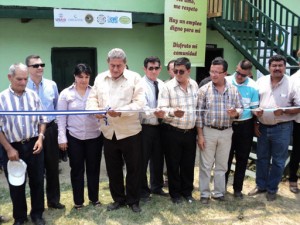 |
| Opening of Outreach Center in La Amistad, Choloma. |
By the end of June 2011, Outreach Centers in El Salvador, Guatemala and Honduras will number 61, providing thousands of children and youth with a refuge that not only provides entertainment but also a place to do homework and to obtain basic skills and vocational training. In Honduras, alone, more than 4,000 youth from the country’s most violent neighborhoods attend and participate in the Centers’ activities nationwide.
The Brotes Nuevos Center received eight computers from AJR USAID-SICA on its opening day. Showing the growing government interest in the area, President Lobo complemented his visit with an additional donation of another eight computers. Forty-seven beneficiaries are already being trained in the first free of charge computer training center in the city.
Philosophically and practically proactive rather than reactive, the Outreach Center model is particularly critical to Honduras, as in Guatemala and El Salvador, where homicide rates are among the highest in the world due to a large youth population with limited education who lives in violent neighborhoods and are prey to gang recruitment. Over the years, various governments have tried to pacify an alarmed citizenry by insisting that the mano dura – hard hand – policy would be effective in curbing crime rates and gang activity.
But, years of analyzing the reasons impoverished youths in some Central American countries fall prey to gangs and other criminal activities by Creative experts, Harold Sibaja and Salvador Stadthagen have concluded that the only way to stem the tide of youths lost to the streets is to provide proactive options that help to structure and guide them as they face tough life decisions. According to Sibaja, the intent of the Centers and the overall youth campaign is to develop new leadership that promotes a culture of life in contrast to the culture of death that reigns in many of these communities.
“We are also financing an anti-drug consumption prevention campaign in collaboration with the government of Honduras which will include radio spots on the Catholic Church’s radio station utilizing a Miskito boy and girl as characters,” said Stadthagen. “The campaign will include posters, T-shirts and school presentations. The drawings for the T-shirts are going to be made by the New Sprout Center’s micro-enterprise.”
Not only do the Centers provide a safe haven for youth which include training in various trades, they are also a low-cost sustainable alternative and rely primarily on community volunteers with only the coordinator of the Center being a staff member. Accordingly, more than three thousand young people and hundreds of volunteers are already part of the Outreach Center effort in the three countries. For Puerto Lempira which is also the capital of the Gracias a Dios (Thanks be to God) Department of Honduras, perhaps a new day is dawning for its youth, one with opportunity to pursue aspirations that will trickle-down to the next generation.[/vc_column_text][/vc_column][vc_column width=”1/12″][/vc_column][vc_column width=”1/4″][vc_widget_sidebar sidebar_id=”sidebar-primary”][/vc_column][/vc_row]
Central America: USAID Youth Alliance-supported Organization Wins Major Foundation Grant
.A Guatemalan organization, Alianza Joven, was selected for a $300,000 “Helping Those Who Help” grant by the prestigious Guatemala-based Gutierrez Foundation. Alianza Joven’s proposal stood out from among hundreds of submissions received by the foundation. To qualify, Alianza Joven had to be formally incorporated, provide its financial reporting and demonstrate positive impact in the community. A beneficiary of the Outreach Center in Escuintla named Moises accepted the award on behalf of the organization.
Alianza Joven was in strong company as one of five finalists. The other finalists included an organization working in urban slums and rural areas; an NGO that provides support to micro-enterprises; a well-known education provider and a local NGO protecting the rights of indigenous women.
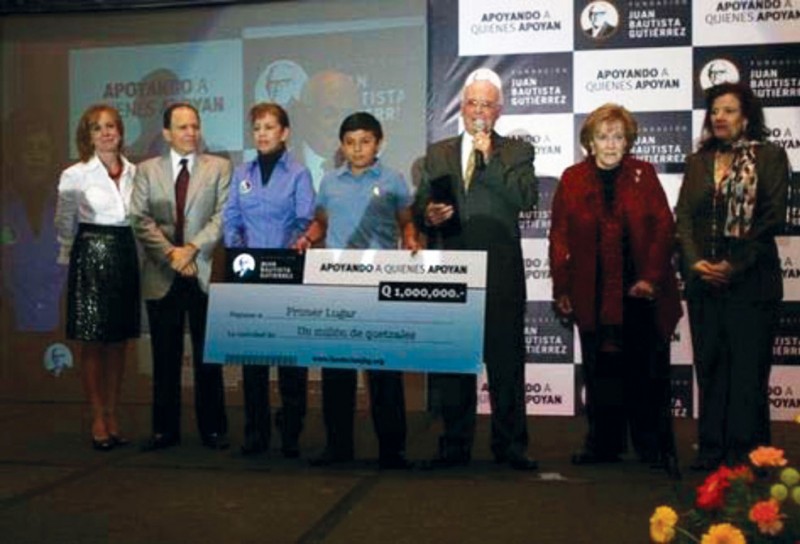
The Gutierrez Foundation received thousands of text messages nationwide from Guatemalans who voted for Alianza Joven for achieving significant change for youth-at risk in some of Guatemala’s most dangerous neighborhoods through its “Outreach Centers.” Alianza Joven’s methodology is based on Creative’s Outreach Center model developed under the USAID’s Youth Alliance Program. Alianza Joven manages fifteen Outreach Centers in Guatemala. Harold Sibaja, Director of the USAID Youth Alliance Program underscored, “The prize awarded to Alianza Joven, the local Guatemalan NGO, represents a national recognition of the Outreach Center Model as a mechanism to prevent crime.”
Creative conceived the Outreach Center model in 2006 as a community-based, volunteer driven initiative to provide services to youth in neighborhoods where gangs and violence have prevailed. Outreach Centers are established in collaboration with local churches, the private-sector and municipal governments. The Outreach Centers provide a safe space that offers youth creative use of free time, including training in English and information technology, tutoring in school work and remedial education opportunities. The Centers have been embraced by communities, who welcome this alternative to youth joining gangs. Schools and other institutions increasingly refer youth to the Outreach Centers. University students are volunteering at Outreach Centers as teachers and as trainers in information technology and computer maintenance.
The Outreach Center model has evolved over time. The Outreach Center model currently includes the following components: “The Challenge of Dreaming my Life” life skills training; information technology and English language skills strengthening; support of youth-focused microenterprise models; and volunteerism development and collaboration with partners focusing on the sustainability of each Center. Youth Alliance project funds cover basic operational materials and provide a salary for a Coordinator for a limited period, after which time Centers must provide for their sustainability. Seventeen Outreach Centers were established in Guatemala by USAID through Creative Associates International.
Under its current AJR USAID-SICA program, Creative has established nine Outreach Centers in El Salvador and Honduras, with another 34 planned for the two countries. More than 6,000 youth have benefitted from services at Outreach Centers in El Salvador and Honduras since May 2008. In the third quarter of 2010, volunteers in El Salvador and Honduras provided more than 11,000 hours of service to beneficiaries.
It is not the first time the Outreach Center Model has received acclaim. In 2010, the Gloria Kriete Foundation in El Salvador awarded an Outreach Center partner known as “Fe y Alegría” (Faith and Joy) a $30,000 prize recognizing services provided to at-risk youth through two Outreach Centers.
David Barth, the director of USAID’s Office of Education, speaks with Creative Times about Technology and Education
.[vc_row][vc_column][vc_column_text]
David Barth
the director of USAID’s Office of Education, speaks with Creative Times about Technology and Education
[/vc_column_text][/vc_column][/vc_row][vc_row][vc_column width=”2/3″][vc_column_text]Q: What benefits and caveats do you see with regard to the use of computers and information technology in educational reform and in the classroom?
Technology in education is highly contextual. One has to ask what technology – if any – is the most appropriate and accessible for what intended educational outcomes are fundamental questions, particularly in many of the low-resource countries where we are working. Even research in more developed countries, including the US., suggests that the utilization of technology in classrooms will not produce learning gains independent of time in the curriculum, proper integration into subject matter context, and teacher training There are indeed 21st century skills which classroom technology can facilitate – problem-based analysis, online collaboration, teamwork – but you would need creative learning opportunities and space within the curriculum within a classroom to maximize technology utilization in these areas. A particularly promising area where technology could prove extremely useful is in education system strengthening. For example, we are supporting the development of both national and school level education management information systems which can track school level administrative data, such as number of students at a school, teacher and student attendance, and other data points that can substantially improve school effectiveness and ultimately learning.
Q: Is USAID seeing a demand for this technology in schools from host countries? Are there recent examples of this that stand out?
Yes, in many of our countries there is keen interest in technology as these are seen as visible reference points of progressive and relevant 21st century skills development. One of our roles is in helping our country clients think about the associated total cost of ownership implications for various technology-supported interventions. We have a wide range of technology interventions that we have supported, from Interactive Radio Instruction in several African countries, the development of children’s television programming in Indonesia and elsewhere, and teacher training college and classroom ICT integration in Egypt, Jordan, Jamaica and Kenya just to name a few. We do insist that we will only fund technological solutions where the interventions are appropriate and where there is a demonstrated commitment to utilizing and maintaining systems. There are too many cases where technological solutions have been left to atrophy because of a failure to maintain and keep current a particular system.
Q: USAID’s implementing partners at times find it is difficult to get beneficiaries, who are just starting out with education technology, to focus on how the technology is used to improve learning or school management rather than just the infrastructure itself. Based on USAID’s experience, what is the best way to engage beneficiaries on this deeper level?
To start at the ground level in discussions with these partners and government stakeholders and to ask the fundamental questions identified above – what learning impacts are you hoping to obtain, what are your human, technical and financial resource constraints (total cost of ownership). And it is very important to assess the trade-offs. If we undertake this particular course, what are we NOT doing? Because of the relative newness of many of these programs, countries need to understand that results are not guaranteed. And without a more comprehensive program of reform, results from technology alone are not likely to be great.
Q: How has USAID used public-private partnerships to promote the effective technology in schools? Are there particular successes that come to mind? Are there cautions or limitations that readers should be aware of?
We are enormously excited by a number of current and proposed Global Development Alliance Partnerships with private sector organizations, including with Microsoft, Cisco and Intel. We are particularly proud of the models piloted in Kenya and now Tanzania, where these three organizations along with local partners have collaborated together to strengthen education programming. Being able to harness the vast experience of private providers has deepened our knowledge pool and is allowing for the flourishing of all manner of innovation. Interestingly, we find that much of the innovation is coming from our local partners. The private sector partners bring in brilliant ideas, but it is the local partners that help us understand how to put them to work for the benefit of their citizens.
Q: From your perspective, what are the main reasons why technology projects succeed or fail?
Individuals and organizations are keen to explore new approaches for education impact. Technology is often seen as a short-cut in this regard. As previously noted, it’s just one tool among many in bringing about improved learning outcomes. Its proper contributing role needs to be contextualized within a broader education framework and dialogue. In technology projects, the hardware and software typically represent 20-30% of your total project/program implementation costs. Countries fail to factor in teacher training, maintenance, upgrading, evaluation etc. They severely underestimate the cost of the programs and overestimate the immediate impacts.
Q: What role do you see donors playing in the future with regard to information technology in education?
Donors have a vital role in supporting innovative pilots, in helping evaluate program successes, and in disseminating the most current and useful information about the role of technology in education. We have the benefit of working in over fifty countries and have seen the programs that both success and fail. Donors can also play a pivotal role in helping to scale-up promising practices. Lastly and perhaps most importantly, donors can help broker the public-private alliances around technology that will provide the sustainability of the project long after our particular program has ended. If we can help in these three areas, we will have done well.[/vc_column_text][/vc_column][vc_column width=”1/12″][/vc_column][vc_column width=”1/4″][vc_widget_sidebar sidebar_id=”sidebar-primary”][/vc_column][/vc_row]
CENTRAL AMERICA: Restorative Juvenile Justice and a Region’s Important Choices
.The punitive approach to justice long applied to juvenile offenders in many Central American countries calls for zero tolerance. Simply put, this approach is not working. According to police reports and national census data, El Salvador, Guatemala and Honduras have among the highest murder rates in the region. In 2009, El Salvador registered 75.99 homicides per 100,000 inhabitants. In Honduras, the number of homicides registered at 68.9 per 100,000, while in Guatemala the rate registered is 48.3 per 100,000. Homicide rates not only continue to rise, but those convicted often further entrench themselves in illegal activities while in the criminal system. In contrast, restorative justice is gaining traction as a viable alternative to hard handed measures. Applied to offenders, restorative justice focuses instead on the harm caused to the victim, their families and society. In this way, restorative justice acknowledges both the victim’s need for reparation and the perpetrator’s need to take responsibility for and understand the damage caused by actively engaging in restitution for the crime. The Creative-implemented Alianza Joven Regional USAID-SICA program is strengthening legal juvenile justice frameworks at the regional level and in El Salvador, Guatemala and Honduras.
In light of the vast challenges faced by the juvenile justice systems in these three countries, Orietta Zumbado, a Judge who leads USAID-SICA AJR’s juvenile justice component, recently sat down with international restorative juvenile justice expert, Victor Herrero. The two team members discussed alternative justice measures in Central America. Herrero, who has applied restorative juvenile justice in more than ten countries, is currently working with AJR to strengthen the institutions responsible for oversight and control of alternative sanctions imposed on minors, so that these more efficiently and more effectively impact recidivism indexes and improve the capacity for the social rehabilitation of offenders.
How does one define restorative juvenile justice?
By definition restorative juvenile justice is a new vision of the justice system. It strongly incorporates the rights of the child, responsibility of the minor under due process and the principle of Opportunity, Flexibility and Social Participation.
Restorative justice goes beyond the mere legalities, and calls for an ethical focus in managing the justice system. The crime committed is not considered so much as an affront against the State but rather an affront against the victim and society. The response must be coordinated across institutions mandated to make the criminal juvenile justice process a space of opportunity for the young offender. The restorative justice criminal approach ensures the youth takes responsibility and agrees to make reparations for damage caused. Such an approach to criminal proceedings reflects a pedagogical focus. A diversified response is applied and takes into consideration the severity of the crime committed and the circumstances of the youth implicated in the crime. In general, all Criminal Codes provide for restorative measures, especially as applied to minors and juvenile offenders because incarceration is a response of last resort—an exception.
Why is restorative juvenile justice needed in Central America at this particular time?
In the face of violence, the State often responds by legislating repressive measures. This hardening of laws neglects the causes that provoke violence and crime. If we compare this to a health intervention, it would be as if we were trying to resolve all health problems by admitting patients with any type of illness or stage of illness into intensive care. Everyone knows that the system would collapse immediately and would be inefficient. A large portion of Central American youth is on the margin of society. They are looked upon as enemies instead of the future of our societies. This state of affairs cannot continue.
Can restorative juvenile justice help to diminish violence?
The restorative focus on alternative measures helps to diminish violence indices by making youth responsible and allowing the victim of the crime to feel a sense of justice. We should be clear that when a youth reaches the criminal system, it is evidence of a failure of other systems. I think the restorative justice vision is a moral, ethical and social responsibility.
Does restorative justice go beyond judges, police and prosecutors?
In restorative justice, the victims are key. This approach should not be confused with soft justice or with impunity, but rather the opposite. What is sought, in all cases, is that the young offender assumes his or her responsibility. We have to make available support services to victims to minimize the damage suffered as a result of the crime committed against them. When young offenders are brought before the process, they are made to understand their crime and take responsibility for their actions before all parties involved. To help youth to make amends for their crimes, it’s important to structure sound mediation services, and efficient programs. For example, in this region, it would be important to strengthen community services.
What country or countries have ideal or effective models when it comes to adopting restorative juvenile justice practices?
In the Central American context, it’s important to observe good practice. A restorative juvenile justice project implemented by the NGO, Terre des Hommes in Nicaragua is applying a restorative focus on youth in working with the Supreme Court, juvenile affairs offices and law enforcement. Institutions responsible for administering alternative measures have perfected their procedures and coordinated actions with institutions to apply alternative justice measures cited in the country`s Code on Children and Adolescents. An innovative information system allows them to manage cases. The system generates alerts to juvenile justice officers with regard to cases and allows them to access, share and analyze real-time data to make informed and timely decisions. I know of a special youth police unit that employs prevention measures in coordination with criminal juvenile justice institutions. We must capitalize on these positive experiences.
What are our mechanisms for strengthening state institutions?
Above all, from the viewpoint of NGOs or international development, we have to consider the need to accompany States in strengthening their institutions. This is one of the greatest contributions USAID-SICA-AJR can generate in the region. The project supports and strengthens precisely those institutions directly involved in the implementation of alternative measures in El Salvador, Honduras and Guatemala.
AJR´s strategy for strengthening rehabilitation systems is noteworthy. One of the greatest problems in the system is at the intersection of coordination, monitoring and control. We are working with juvenile judges applying the sentences and with the offices charged with monitoring and controlling restorative measures. In El Salvador, this is through the National Institute for the Integrated Protection of Children and Adolescents (ISNA). In Guatemala this is through the Secretariat for Social Well-being. In Honduras, we are working through the National Institute for Families and Children (IHNFA), this is a first and important success. The interesting aspect of the Creative led USAID-SICA AJR project is that strengthening these systems translates into very practical and specific alternative measures. The project supports inter-institutional coordination in order to provide youth with increased alternatives and a space of opportunity.
As a collateral result, coordination between the institutions has improved, fostering trust between them. The project’s challenge and also its greatest strength is its regional dimension. Facilitating these countries’ work through common elements will ensure that the treatment of crimes will also have positive impact at the regional level. This without a doubt, will in the medium term mean a very different situation for the youth of Central America.
Gangs in Central America’s Barrios: Children without Childhoods
.By Salvador Stadthagen
Some barrios in El Salvador and Honduras are incongruously known by such names as “Divine Paradise” or “Heaven’s Field.” If you walk down the paved streets of of Mejicanos, Apopa or Soyapango in El Salvador or Nueva Suyapa, Rivera Hernández or López Arellano in Honduras you will see people have water and electricity. There is even a scattering of businesses and industries with signs advertising Coca Cola or purified water. These barrios give the appearance of “tolerable” poverty. The reality for young people growing up there is far darker and dangerous than appearances would suggest. In these barrios, a youth’s life is worth less than a pair of Adidas sneakers, or a cell-phone, or a branded T-shirt. These barrios are at the heart of the youth and gang phenomenon.
The USAID-funded Regional Youth Alliance program I lead in coordination with the regional Central American Integration System (SICA) recently conducted focus groups with young people in Tegucigalpa’s most violent neighborhoods. The story they tell is grim. Young people in enormous barrios of 160,000 like Chamelecon or López Arellano in Honduras, have few safe places they can go. Children are growing up without childhoods. Young people are afraid to leave their houses at night, afraid to walk to school or work in the morning or to come home in the evening. Even soccer fields, long a healthy fixture of life for Central American youth, are no longer safe. Many homicides are now occurring in broad daylight during games.
Gangs are becoming embedded in the very fiber of the community. Schools are becoming a dangerous place. A wave of homicides and extortion is engulfing the public school system in El Salvador. Extortion is becoming a way of life. Staying alive has a cost—you have to “rent” it. Students pay the gangs a quarter a day to be able to study. Teachers are intimidated into paying renta or protection money to neighborhood gang members from each paycheck. Young people providing door-to-door services (repartidores), bus drivers and ticket collectors are being killed for not paying their “rent.” Younger children collect for their 16-18 year old gang bosses and when they do not present clear accounts they too are killed. The homicide rate in El Salvador jumped to over 75 per 100,000 in 2009 and most of the perpetrators are young people.
In El Salvador, gang structures are more solid and militant, retaining a traditional gang culture. In Honduras, youth gangs are gravitating to carrying out killings and trafficking for drug criminals. The links between drug traffickers and gangs are becoming more apparent, in El Salvador just as they are in Honduras and Guatemala, as traffickers dump drugs along transit routes which gangs now increasingly peddle locally.
Emigration has undermined family structures. Many former gang members tell us that they were raised by grandmothers or relatives. In El Salvador, an estimated one-fifth to one-fourth of the country’s population went to the U.S. to find jobs. Parents left their children to be raised by grandmothers, uncles, cousins, and even by older siblings. The parents sent money to pay for food, school supplies, medical care, even local college tuition in some cases. But, growing up without their parents’ influence and protection, these children became fertile ground for gang recruitment.
Deportees from Los Angeles’s ghettoes or prisons reinforce gangs in their home countries and strengthen international criminal links. Deportees who come back to semi-rural communities set up urban-style clicas (cells). As paid assassins, or sicarios, hardened criminal deportees collect enough money to return to the U.S. in as little as three months. Other deportees to Honduras, El Salvador and Guatemala barely speak Spanish and are easy prey for recruitment into local gangs.
The gang stigma attached to these barrios makes it even harder for young people to find jobs. Youth from Nueva Suyapa told us they do not dare to place the name of their barrio on job applications, as they would be automatically refused. Instead they list a more acceptable barrio.
Barrio communities need their Government and donors to help them address the gang problem head on. Lasting approaches to the viral nature of gangs have to understand the realities of these barrios. Building a soccer field might seem obvious until you understand that many parks and fields but also community buildings and even schools are already there but have been abandoned or are underutilized. Reinforcing and rehabilitating the “hardware” of such infrastructure needs to be tied to the “software” of programs that deliver a protective and nurturing environment.
Faith-based organizations need support. They are almost universally present and often the only cement holding the crumbling foundations of these communities together. With meager resources, these priests, pastors and missions help people facing a lethal combination of exclusion, high urban poverty, migration, and insecurity.
Public, vocational, and parochial schools are an important place to start. Scholarships can, for example, cover $10 monthly vocational school fees, buy otherwise unattainable school uniforms and books, and cover bus fare to get young people into a healthy environment. Larger, more problematic schools can be provided with psychologists and other advisors. Currently, difficult and truant students are expelled from school, which only feeds the cycle of gang crime.
A good observer of the street scene in Central America recently incredulously remarked that she saw no public campaigns in the barrios: no posters warning about drug abuse and violence or positive, reinforcing messages for youth. Instead, gang graffiti is ubiquitous. I still remember the effective “fried egg” campaign against drugs when I was in college in the U.S. To have a chance, the communities in these barrios need public campaigns, on radios, TV and particularly in the streets.
EL SALVADOR: Indirect Path Brings Youth-at-Risk Program Officer to a Happy Place
.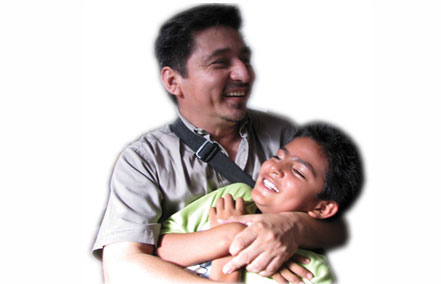
Juan Jose Hernandez’s professional trajectory has been anything but conventional. From the priesthood he turned to psychiatry and from there to becoming El Salvador’s chief of police following a brutal civil conflict. Yet, says Hernandez, throughout these years, he was not meandering aimlessly.
Serene though with a contagious energy, Hernandez has traveled wide in search of self-understanding so that he can enrich the lives of those he serves. His story is as compelling as it is inspirational to those who come into contact with him.
“The seminary, psychiatry, the police, they all have a common purpose and that is to help others,” said Hernandez, currently the program officer for the Regional Youth Alliance USAID-SICA project, which is implemented in El Salvador, Guatemala and Honduras. The goal of USAID-SICA is to provide constructive alternatives to a life on the street for youth-at-risk and former gang members. “I learned from the different fields: from the seminary, I learned empathy, from psychiatry, I learned science and in my years with the police I learned the significance of action.”
At 13, Hernandez’s mother took him to see the bishop after he informed her of his desire to become a priest. The bishop was none other than the late Monsignor Oscar Romero, a committed human rights advocate whose outspokenness led to his assassination in 1980. Though Hernandez did not join the seminary there and then, Romero told him if he still wanted to become a priest after his high school graduation, he could do so then. “He, Romero, told me, he would wait for me,” Hernandez recalled. It was to be their first and last meeting, “but, [Romero] remains an inspiration for me and many others.”
Over the next few years, Hernandez led the life of a typical teenager with few thoughts of the seminary. However, after graduating high school at 17, Hernandez entered the seminary. Five years later and two years shy of his ordination, Hernandez abruptly changed course, and moved to Italy to study psychiatry. “I would have been a priest at 24-years old. I was afraid to fail,” Hernandez noted.
Despite the raging conflict in El Salvador, Hernandez returned to his country in 1988, and having had significant training in clinical psychiatry, he took a post at a psychiatric hospital. When the conflict ended, he re-directed the course of his professional life by joining the national civilian police force. “I felt I could be most useful there, because after the war there was a need to build the peace, it was my way of supporting the movement toward peace, public security. It was essential,” said Hernandez who eventually became chief of police.
Spending nearly a decade with the civilian police gave Hernandez insight into the needs of the population and an awareness of those most likely to fall victim to crime. From the civilian police, Hernandez joined the UN Mission in El Salvador which later transferred him to their Guatemala office. In Guatemala, he joined a small USAID-funded program, the Youth Alliance Program, aimed at marginalized communities and youth-at-risk, the precursor of today’s Regional Youth Challenge USAID-SICA project. Implemented by Creative Associates International on behalf of USAID, the youth project has mobilized communities and businesses in its efforts to rehabilitate former gang members and to provide safe spaces where marginalized youth spend free time constructively.
“Last year, 7 youth with whom we worked were killed by other gang members,” said Hernandez. “You feel angry when they die, they’re gone.” Hernandez’s natural calm and good humor faded momentarily in anguish. “But, at the same time you take some comfort in knowing that person had shifted his life in the right direction, was on the good side.”
Hernandez has been deeply influenced by psychiatrist and holocaust survivor Victor Frankl who taught that, no matter what the situation, people have the freedom to choose the course that will alter their circumstances allowing them to transcend horrendous suffering. This human capacity to overcome dehumanizing circumstances by becoming spiritually and mentally whole again is at the core of Frankl’s teaching and guides Hernandez’s work with young people.
Despite the seriousness of his life’s work, Hernandez concedes, “I am happy with my history.”
“I believe sincerely that we are here to help others. Neither riches nor genius is needed” he says, “only a heart and a desire to help others. Creative Associates and USAID have given me the opportunity to help those who really need help in their communities, especially youth-at-risk.”
EL SALVADOR: The Call for Restorative Justice
.Violent crime by young gang offenders in Central America is highly exposed in local media and weighs heavily on the administration of justice. While getting tough on crime is politically appealing, grappling with reality is far more complex. Juvenile Justice Magistrate Doris Luz Rivas Galindo of El Salvador underscores the point: “I sent a juvenile offender to a juvenile detention center with no tattoos and when he left the center he was completely tattooed and without any aspirations in life. I felt like an accomplice.”
USAID’s Regional Youth Alliance Project is empowering governments and civil society to reduce the numbers of youth who join gangs or break the law by improving Juvenile Justice and applying restorative justice solutions. The long term strategy is to reverse the trend of economic stagnation. The prevalence of delinquent youth discourages legitimate businesses, perpetuating unemployment that fuels gang recruitment and crime. The Alliance works in close collaboration with the Central American Integration System (SICA), an intergovernmental organization of regional states.
The concept of restorative justice is rooted in international law. The United Nations Vienna Declaration on Crime and Justice (2000) encouraged the “development of restorative justice policies, procedures and programs that are respectful of the rights, needs and interests of victims, offenders, communities and all other parties.”
According to the United Nations, “Restorative justice refers to a process for resolving crime by focusing on redressing the harm done to the victims, holding offenders accountable for their actions and, often also, engaging the community in the resolution of that conflict.” Under this approach,“…the victim and the offender, and, where appropriate, any other individuals or community members affected by a crime, participate together actively in the resolution of matters arising from the crime, generally with the help of a facilitator.”
In El Salvador, there is a strong social perception that juvenile delinquency needs to be dealt with harshly. El Salvador’s current heated debate about raising sentencing limits for children 17-years and younger from 7 to 15 years is a case in point. Salvador Stadthagen, project director of the Regional Youth Alliance Project in El Salvador, Guatemala and Honduras, points out that approximately 6-8% of violent crimes are actually committed by juveniles. A February 1, 2010 report by the Juvenile Justice Unit of El Salvador’s Supreme Court substantiates the point, recording only 661 juveniles currently detained. Many more received alternate measures that get little follow-up.
The call for restorative justice is driven by the need to comply with international standards with respect to the rights of the child and to respond to rising crime rates in Central America. Faced with the choice of sending a child back into a life of crime, Judicial practitioners such as Justice Galindo are seeking out the restorative justice approaches being advanced by the Alliance. In 2008 and again in 2009, the Alliance organized successive Regional Juvenile Justice Forums in Tegucigalpa and San Salvador. Attended by judges, international juvenile justice experts, SICA and U.N. representatives, the gatherings provided restorative justice recommendations to the governments of El Salvador, Guatemala and Honduras.
“Youth are more malleable and likely to benefit from a system that promotes restorative justice over traditional justice,” said Stadthagen. “Also, unlike traditional justice that focuses on the criminal, restorative justice also focuses on the victims, opening the way for reconciliation and reparations.”
Influenced by the Alliance’s work, policies and practices involving alternative restorative justice measures are evolving. Unfortunately, governments lack resources to invest in these initiatives. The 2008 budget of 3.4 million dollars for the Salvadoran Institute for Integral Development of Children and Adolescents represents less than one half of one percent of the national budget. Likewise in Guatemala and Honduras, laws provide alternative measures to assist children in trouble with the law, “but assigned officers cannot follow-up with kids, especially those outside of urban areas to make sure they are attending school, literacy classes, and so on, because they do not have funding,” said Stadthagen.
Rehabilitation and juvenile detention centers in the three countries are often overwhelmed. “In El Salvador, there have been 20 assassinations carried out at rehab centers which are dominated by gangs,” said Stadthagen.
“The juvenile justice track is second class. Kids get the larger share of the blame.” In response to this counterproductive approach, the Alliance is encouraging Juvenile Justice systems to offer measures such as supervision, counseling, education and vocational training programs and other alternatives to institutional care for children.
“Our next step is to pursue advocacy and to deepen the qualitative and quantitative analysis of the circumstances governing juvenile justice. We’d like to bring in an academic component to help the process move forward,” said Stadthagen. “We are also considering a pilot program in Guatemala. There, kids in detention centers must visit a judge every three months, for those in rural areas they must travel sometimes more than 400 miles to see the judge because there is one juvenile justice judge in the entire country appointed to serve these kids. We are thinking of a virtual courtroom so that kids wouldn’t have to travel so far.”
As the SICA-led Alliance supports governments in meeting their commitments to improve juvenile justice standards in the region, there’s a glimmer of hope for juvenile offenders and their victims to find reconciliation and a new beginning in life. USAID’S Regional Youth Alliance Project is implemented by Creative Associates International, Inc. of Washington, D.C.
—Alexandra Pratt
GUATEMALA: Historic Soccer Match Between Former Gang Members and Government Officials
.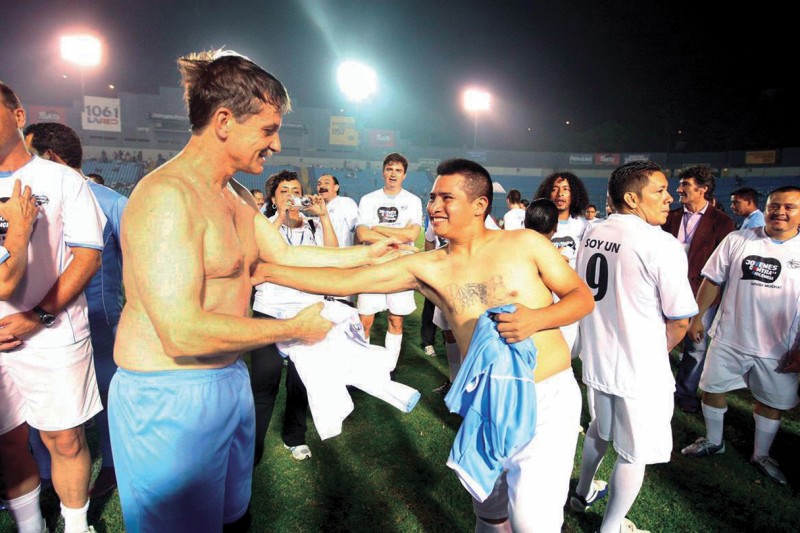
A crowd of 10,000 turned out to cheer as 15 former gang members spilled out onto Guatemala’s Mateo Flores National Stadium to face a team of government officials including the Chief of Police, the Minister of Culture, the Presidential Sports Commissioner, police officers, firemen, and two Armed Forces Generals in an historic soccer match. The event kicked off a multi-faceted “90 Minutes Against Violence” campaign ultimately aimed at engaging Guatemalan youth in making specific recommendations for reducing violent crime.
“The former gang members beamed with pride as they came out of the locker room onto the field, while the Guatemalan anthem played,” said Harold Sibaja, Director of the Youth Challenge Program. The Program has supported the creation of the Youth Movement Against Crime, which is responsible for the Campaign. Funded by the U.S. Agency for International Development, and implemented by Creative Associates International, Inc., the Youth Challenge Program has been designing unique interventions for youth-at-risk since 2003.
The “90 Minutes Against Violence” match included three games of 20 minutes each (Former Gang Members vs. Government Officials, Private Sector vs. Politicians and Diplomats, and Artists and Faith Based Organizations vs. Professional Soccer Players). The match’s last 30 minutes was played among the best players of the three first games. Although the first game’s ending score was 0-0, the crowd was equally delighted with the three subsequent matches. Theatrics helped to drive home the Campaign’s message. In the last match, players purposely broke game rules sending the ball to the wrong goal post and other antics, causing an outcry from fans. The interlude reinforced that without concern for rules, chaos reigns making all equally losers.
The games drew national coverage, focusing attention on the sobering fact that there is a murder every 90 minutes in Guatemala. The country’s homicide rate has soared from 26 per 100,000 inhabitants at the end of the country’s protracted conflict in 1996 to 46 per 100,000 today. The U.S. national murder rate, by comparison, stands at 5.6 per 100,000.
The Youth Movement’s “90 Minutes Against Violence” is reaching beyond traditional media outlets to speak directly to Guatemalan youth who are disproportionately both the victims and perpetrators of violent crime. “Every goal scored in this game symbolized a collective point scored for Guatemala against violence,” said Sibaja who leads Creative Associates’ Youth-at-Risk initiatives in Guatemala and the Latin American region. “With examples such as former gang members and police officers playing side by side, the message of the game was clear — Guatemalans united from every walk of life can combat violence and do not have to accept living with insecurity as the norm.”
With government, private sector leaders and ordinary Guatemalans now speaking up and reinvesting in their communities, “90 Minutes” is not limiting itself to a soccer stadium. The Youth Movement Against Violence organized by USAID’s Youth Challenge Program has literally taken the campaign on the road. Starting October 17th, every weekend for four weeks a bus has traveled through Guatemala City’s most dangerous neighborhoods, including “El Mezquital” where several police officers were recently killed by gang members. Members of the Congress of the Republic, celebrity professional athletes and business leaders aboard the bus are carrying out a “Dignified Life for Youth” campaign to reinforce the anti-violence message.
“Another activity planned countrywide for this campaign is ‘90 Dialogues Against Violence’ to get Guatemalan youth to reflect on violence and to propose solutions to decrease criminal activity,” Sibaja added. “Through these dialogues, we hope to study the cause of juvenile violence using principles — diversity, creativity, compromise, tolerance, unity, active listening — to initiate discussions and impart knowledge. Ultimately, the dialogues will achieve a multiplier effect by having participants impart lessons learned to their peers.”
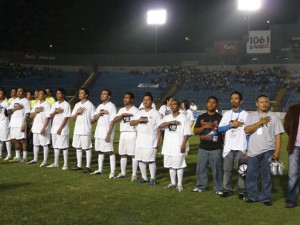
The Youth Movement’s campaign is also planning a major concert to bring young Guatemalans together with the unifying appeal of popular music. The campaign’s goal is to support the draft of a policy paper that incorporates feedback from youth and all sectors of society. The Coalition for a Dignified Youth created under the Youth Challenge Program is using the proposals generated by youth to develop recommendations for a crime prevention public policy paper. The Campaign is a tangible way for young people to make their voices heard on the problems faced by disenfranchised youth in the hope of bringing them into the mainstream to end the cycle of violence in Guatemala.[/vc_column_text][/vc_column][vc_column width=”1/12″][/vc_column][vc_column width=”1/4″][vc_widget_sidebar sidebar_id=”sidebar-primary”][/vc_column][/vc_row]